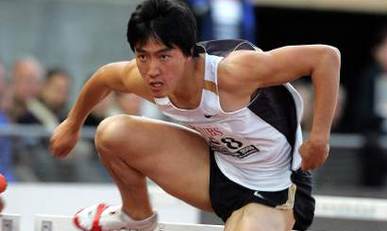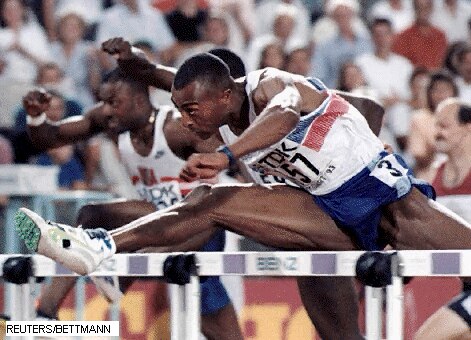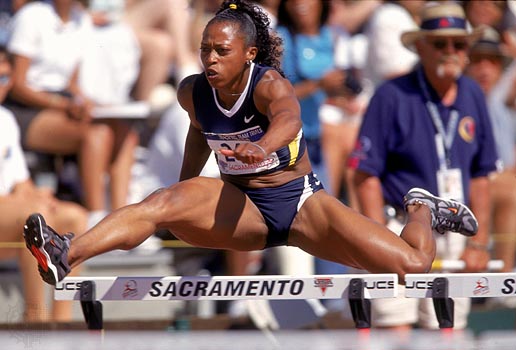While the lead leg is definitely a major factor in providing fast hurdle times, two aspects of technique that often get overlooked in regards to generating speed are the trail leg and the lead arm. Sure, we all agree that these two aspects are important for balance and overall hurdling rhythm, but they can also be used to generate speed coming off the hurdle, and that topic is what this article will discuss.
First off, let’s begin by saying that in the 110m hurdle race, we commonly think that we want to lose as little time as possible over the hurdle, that we want the action of clearing the obstacle to have a minimal negative effect on our velocity. But what I’m saying here is that you don’t merely want to avoid losing speed, you don’t want to merely maintain speed, but you want to actually accelerate coming off the hurdle. In other words, the motion of hurdling actually gives you a boost so that you’re moving faster when you touch down than you were when you took off. You want the act of hurdling to generate speed. But how to do that?
The Trail Leg as the Key to Speed
In order to create speed with the trail leg, you must drive the trail leg forward, with an opening of the groin, when taking off into the hurdle. The knee of the trail leg is still facing forward even though the groin opens up, and it is driving upward, with the ankle of that foot flexed upward. The wider the trail leg’s motion, the slower its motion. Keep it tight as possible, and the ankle flexion will enable you to avoid hitting the hurdle.
Coming off the hurdle, the trail leg knee drives upward as the foot of the lead leg drives downward, so that the quad of the trail leg is parallel to the track when the foot of the lead leg touches down. The trail leg touches down immediately after the lead leg and you seamlessly return to sprinting on the ground. And you should feel a sense of explosion when the trail leg foot touches down.
Snapping down the lead leg without driving up the trail leg causes a twist in the shoulders and hips, and it lowers the trail leg, making its path across the hurdle more left-to-right (or right-to-left, depending on which leg is your trail leg) instead of up-and down. When the trail leg is late, you pause when you touch down. When you’re doing it right, your trail leg will actually look like it’s functioning more as a lead leg.
When I was in high school way back in the day running over the 39-inch barriers, I had a lazy trail leg and never had to fix it. I’d snap down my lead leg, kind of slide my trail leg over the crossbar, and just kind of drop it on the other side of the hurdle. Occasionally I would hit hurdles, but not often. When I first began hurdling in college over the 42’s, I was constantly smacking hurdles with the knee and ankle of my trail leg. So I had to fix it. I had to change my angles, and I had to speed up the timing. The trail leg couldn’t be late, and it couldn’t be slow, and it couldn’t come around in a wide, circular motion. It had to be up-and-down. Once I got the hang of it, that’s when I finally felt like I was hurdling. It didn’t just feel rhythmic, but it also felt powerful.

World record holder Liu Xiang exhibits the tight trail leg motion that enables him to accelerate when coming off the hurdle
The Lead Arm as the Key to Speed
To me, the most important factor in generating speed off the hurdle is the lead arm. The lead arm dictates so much of what the other parts of the body do that it’s not even funny.
The lead arm should never stop moving. From take-off to touchdown, the lead arm never stops moving. Throughout the entire hurdle race, from the first step to the last, the lead arm never stops moving. If the lead arm pauses, both legs will also pause. Just as with sprinting, the legs will do what the arms do. The lead arm should move in a straight up-and-down motion, opening up the elbow slightly to allow room for the trail leg to come through. But there should be no lateral motion – no side-to-side motion with the lead arm. Such motion causes major balance issues and slows you down considerably.
Taking off into the hurdle, the lead arm drives up with the lead leg. Then the lead arm starts its downward motion before the lead leg does – before the foot of the lead leg has even reached the crossbar. To create acceleration off the hurdle, this downward motion of the lead arm has to be a quick, forceful, thrust. It can’t be smooth, and it can’t be fluid. It has to be forceful. Why? Because, coming off the hurdle, the downward thrust of the lead arm helps to push the lead leg down, and to push the trail leg up, all of which pushes the torso forward and sends you sprinting toward the next hurdle.

Former world record holder Colin Jackson forcefully drives down his lead arm as he begins his descent off the hurdle.
Is it the Same for Girls?
Unfortunately, not much of what I’ve said in this article really applies to the women’s race. When the men move up to the 42’s, they must make the necessary technical adjustments to ensure a smooth transition. A 42-inch hurdle will always let you know when you’re being lazy, careless, or are becoming fatigued. For the women, because the hurdles never get any higher than 33 inches, no such adjustments ever become necessary. That’s why you see so many outstanding female hurdlers with glaring technical flaws. Their speed masks their flaws. In the women’s race, the faster you are, the better you are. Assuming, of course, that you’re not afraid of the hurdle.

Gail Devers, one of the fastest female hurdlers ever, never had to develop the tight trail leg that is essential for male hurdlers.
© 2008 Steve McGill
